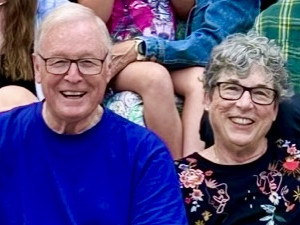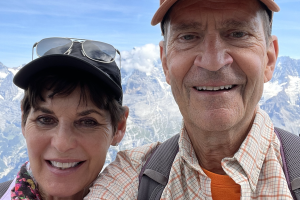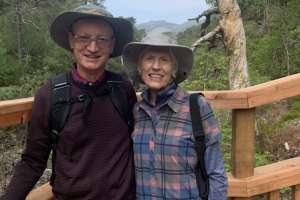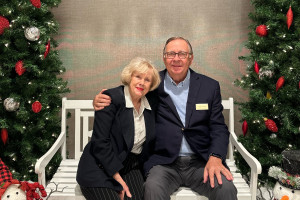"Sewanee is a part of my family and always will be."

Around the time four lads from Liverpool, England, were storming the American music scene, a different Fab Four was shaping up at Sewanee. Joel Smith, John Taylor, Lee Thomas, and Paul Frantz, all C’67, certainly kept lower profiles than the Beatles in the 1960s, but the Exornati alumni have achieved a legendary feat on the Mountain—during their 55th reunion last year, they built on the success of their class’s 50th reunion project by raising more than $1.3 million for an endowed scholarship fund. The fund honors their late classmate Albert Sidney “Bert” Polk, C’67, who served as class agent and was, in Smith’s words, “the quintessential Sewanee gentleman in every category.”
Aside from their shared fundraising accomplishment, Sewanee’s Fab Four have only a few details in common. Joel Smith, C’67, P’99, says he first stepped onto the University’s campus during “a typical Sewanee weekend,” complete with the Mountain’s famous fog and mist. Paul Frantz, C’67, on the other hand, was dropped off on a weeknight by one of Sewanee’s assistant football coaches. As Frantz describes, he arrived a week before classes started, as a new recruit on Sewanee’s football team. “It was dark, and I’d never been on campus before,” he says. “The following morning, I woke up, and I was in a completely alien environment.”
Fortunately, all four men found their Sewanee bearings relatively quickly. While Frantz, who is a retired cardiovascular surgeon, majored in biology, Smith and John Taylor, C’67, pursued political science. Lee Thomas, C’67, H’20, believes he may have been the University’s first psychology major. Thomas transferred to Sewanee from Clemson University at the suggestion of his father, after realizing that Clemson’s engineering track wasn’t a good fit. As alternate plans go, Sewanee wasn’t a random choice—Thomas’s father, brother, uncle, niece, and great-niece and -nephew all earned their undergraduate degrees on the Mountain. “My family has been associated with Sewanee for over 100 years,” Thomas says.
One experience united all members of the Class of 1967: the Vietnam War and related anxiety about the war draft. By the late 1960s, student deferments were limited to two fields of study: medicine and theology. “Those of us who had not applied to medical school or seminary were taking our chances,” Smith says. Though Smith was admitted to law school during his senior year at Sewanee, he instead chose to enroll in Officer Candidate School. Ultimately, he spent three and a half years on active duty in the U.S. Navy, serving as a navigator aboard a guided missile destroyer. Similarly, Taylor served in the U.S. Army for six months after graduation. While Taylor eventually entered law school and had a five-decade career in business law, Smith shifted into banking, starting out at Bankers Trust in 1971 and becoming president of Bank of America East.

Frantz says he’s almost certain he would have been drafted and deployed to Vietnam if he hadn’t been accepted to medical school—he was a reserve officer during his time at Sewanee. During his first weeks on campus, while he was practicing for the football season, he roomed with Dale Reich, C’66. Frantz recalls Reich joined the military after Sewanee and was killed within a few weeks of deployment. “In our class, and in our age group, there are very few people who don’t know at least one person who was killed in Vietnam,” Frantz says.
Bert Polk, too, served in the military—after earning a B.S. from Sewanee and an MBA from Marymount University, he was commissioned as an officer in the U.S. Navy. During his decades of service, he was awarded the Defense Meritorious Service Medal and the Navy Meritorious Service Medal. Thomas describes Polk as “an incredibly strong Sewanee alum” who excelled at sharing class news and keeping classmates in touch through the years. Taylor, who spoke on the phone with Polk only a few days before Polk’s death in 2014, says it was an easy decision to honor the beloved class agent through 50th and 55th reunion projects. “When our class came up with the idea of creating an endowed scholarship in Bert’s name, I certainly wanted to be involved,” he says.
As their 50th reunion approached, Taylor and Smith worked with Terri Griggs Williams, C’81, Sewanee’s associate vice president of advancement, to develop a class project and decide on a fundraising goal. First, Smith says, he and Taylor had to learn how class projects are defined. Sewanee launched the tradition in 2000, as a unique way for reunion classes to give back to the University. Past projects have ranged from brick-and-mortar endeavors (such as the recent renovation of the Sewanee Welcome Center sponsored by the Class of 1973) to endowed scholarship and internship funds and support for Cornerstone Scholarships.
After learning more about Sewanee’s most pressing needs, Smith and Taylor concluded that an endowed scholarship could significantly advance the University’s mission. As Smith notes, “Sewanee is always competing for top-quality students, and one of the biggest issues in that process is the University’s ability to offer financial aid.” Together with their committee, Smith and Taylor set a fundraising goal of $500,000.

Then, the hard work began. “We made a lot of phone calls,” Taylor says. While not every call led to a gift, there was enough progress to keep committee members motivated. “You have to keep in mind that people have different levels of giving ability,” Taylor says, adding that, in the process of reaching out to classmates, it was important to be well-versed in project aims and to be able to make personal connections. In the end, the committee’s persistence paid off—they raised more than $525,000.
Having surpassed their reunion goal, Smith and Taylor could have hung up their Sewanee fundraising hats—and they did, for five years. In 2022, with 55th reunion celebrations on the horizon, Taylor noticed an article in The New York Times about the complicated mathematical equation that guides college and university admissions. He says the piece noted that, in order to maintain balanced budgets, institutes of higher education must pinpoint how many incoming students can receive scholarships and how much funding is feasible for each financial aid package. “It fascinated me that just about every college and university has to go through this process every year,” Taylor says. “It also occurred to me that what Sewanee probably needed more than anything was more scholarship support.” He called Smith, who had just read the same article. Before long, a 55th reunion project began taking shape.

To assist in steering 55th reunion fundraising, Smith and Taylor got back in touch with Thomas and Frantz, both of whom are longstanding University benefactors and had made calls for the 50th reunion project. Thomas, who directed the Environmental Protection Agency during the Reagan administration and has led multiple international corporations, was instrumental in conceptualizing and funding the University’s Wellness Commons and has provided substantial support to many other Sewanee causes. Frantz has been a major contributor to the University’s pre-health program. With their team solidified, the 55th reunion committee set about securing an additional $300,000 for the Albert Sidney Polk Endowed Scholarship.
As an added incentive for class giving, Taylor suggested establishing a matching challenge. All four committee leaders—Taylor, Smith, Thomas, and Frantz—pledged to contribute significant funds if their classmates could match the overall amount. They also enlisted Allison Cardwell, director of gift and estate planning, to speak with the 55th reunion committee about planned giving. With these new strategies in action, they added about $230,000 to the endowment they had generated five years earlier.
It was an impressive accomplishment, but Taylor says he still felt slightly disappointed. “We were getting close to our $300,000 goal, but we were still short—and our self-created deadline was coming up.” At that point, a Sewanee angel appeared. “Joel called me and said, ‘Someone has given us $600,000 anonymously,’” Taylor says. “It was the greatest thing you could imagine.” With this last-minute boost, the Sewanee Fab Four pushed their project well over the million-dollar mark.
Terri Williams says the tremendous success of these Exornati alumni can inspire other reunion classes. “We often recognize the 50th reunion as a landmark event, and the Class of 1967 should definitely feel proud of their achievements in 2017,” she says. “The fact that they were doubly successful in 2022 shows that any reunion year can be a milestone—any reunion class can transform Sewanee for the better.”
In recognition of their accomplishments, Taylor, Smith, Thomas, and Frantz were presented with Sewanee’s Exornati Alumni Award in a reunion ceremony last year. The award celebrates the Exornati class achieving the highest increase in giving participation during a reunion year. Thomas says he appreciates the honor, and he views his giving as a tribute to his many relatives who have lived and studied on the Mountain. “I’m glad to support the institution that has meant so much to my family for a century. Sewanee is a part of my family and always will be.”

